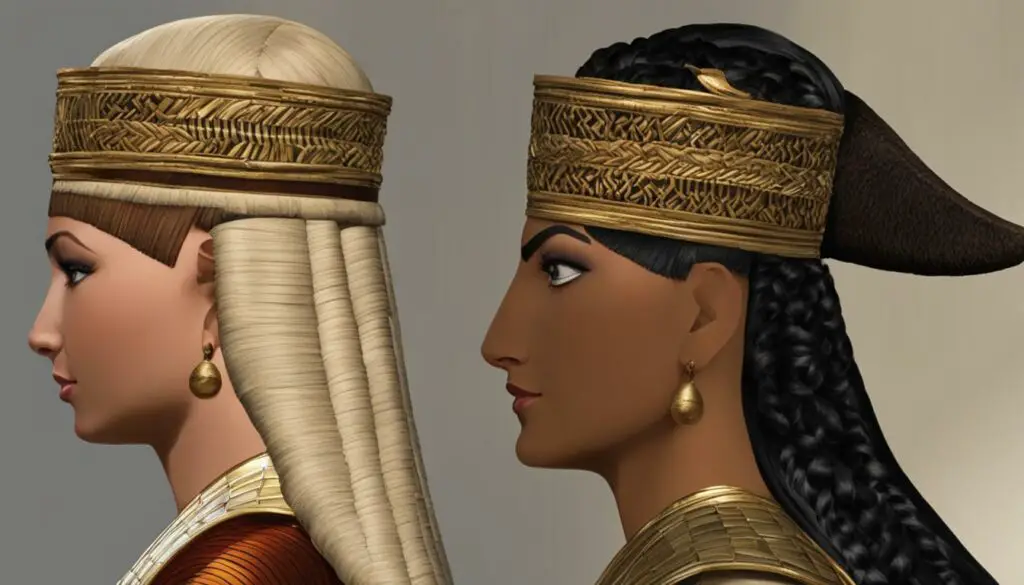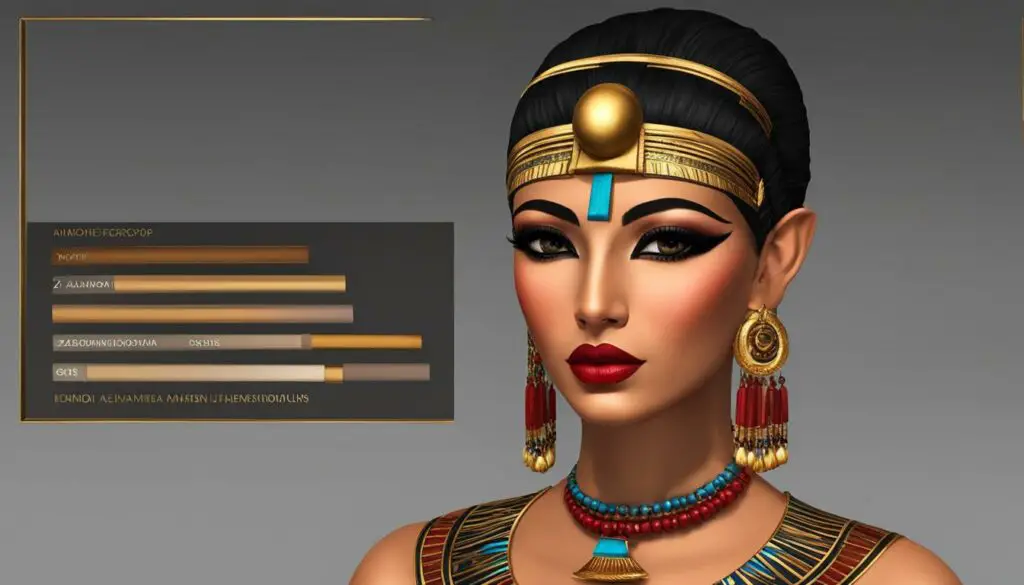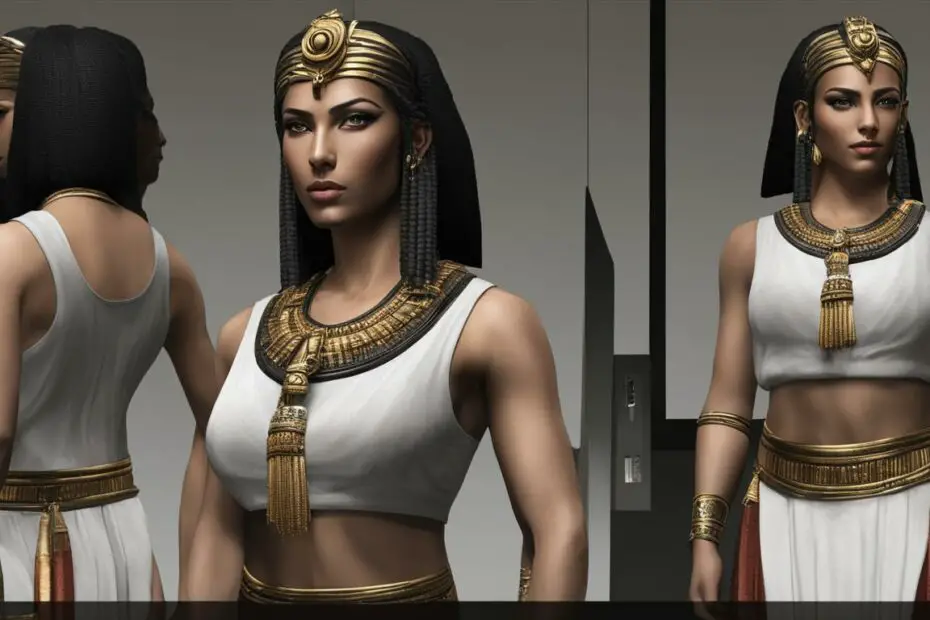Ancient Egyptians possessed unique physical characteristics that distinguish them even to this day. The characteristics of people from Egypt reflect a rich blend of cultural influences, genetic heritage, and environmental factors. From the beauty standards of Ancient Egypt to the grooming practices and fashion choices, the Egyptian physical appearance holds a deep historical significance.
In this comprehensive article, we delve into the various aspects of Egyptian physiques, shedding light on the intricate details that defined their appearance. The beauty standards in Ancient Egypt, hairstyles, clothing, makeup, and notable figures with distinctive traits will be explored.
By understanding the characteristics of people from Egypt, we gain a deeper appreciation for their rich heritage and the enduring legacy of the ancient civilization. Join us on this fascinating journey through time to explore the physical traits and appearance features that make Egyptians truly unique.
Beauty Standards in Ancient Egypt
Ancient Egyptians had well-defined beauty standards that were reflected in their art. These standards of beauty can be observed in sculptures, paintings, and hieroglyphics from that time period. Women were expected to possess a certain physique, while men aspired to have specific physical characteristics.
One of the prevailing beauty standards for women in Ancient Egypt was thinness. Women with slender figures were considered attractive, and this can be seen in the way they were depicted in Ancient Egyptian art. Additionally, small and firm breasts were admired, symbolizing youth and fertility.
For men, the ideal body type was long and lean, with broad shoulders. This physique was often associated with strength and masculinity. The portrayal of muscular shoulders and a flat stomach can be observed in the artwork from Ancient Egypt.
It is interesting to note that these beauty standards share similarities with modern-day ideals. The emphasis on a slim figure and toned physique is still prevalent today, showcasing the long-lasting influence of Ancient Egyptian beauty standards.
Overall, the beauty standards in Ancient Egypt played a significant role in shaping the depiction of individuals in the art of that era. These ideals not only reflected the societal norms and values but also conveyed the importance placed on physical appearance in Ancient Egyptian culture.
Hairstyles and Grooming in Ancient Egypt
Ancient Egyptian women had a wide range of hairstyles that reflected their cultural practices and personal preferences. These hairstyles varied from simple to intricate designs, showcasing the creativity and artistry of Ancient Egyptian society.
One popular hairstyle for women was loose hair, where the hair flowed freely down the back. This style was common among both commoners and noblewomen. Braided pigtails were also a favored choice, with women often adorning them with beads and other decorative elements.
An interesting aspect of Ancient Egyptian hairstyles was the distinctive sidelock worn by boys. This sidelock, known as the “lock of youth,” was shaved except for a section of hair on one side of the head. This sidelock was a symbolic representation of a young boy transitioning into adulthood.
During the Old Kingdom, men preferred shorter hairstyles. However, as time progressed, men started wearing shoulder-length bobs or rows of tight curls. These hairstyles were achieved using various styling techniques and products available during that era.
As for women, their hairstyles became more elaborate over time. Women started incorporating layers of curls or waves into their hair, creating intricate and voluminous looks. Wigs were also commonly worn by women, which allowed for versatility in length, style, and color. These wigs were often made of human hair and were a symbol of beauty and status.
It is worth noting that facial hair was not common among men in Ancient Egypt. However, some statues and depictions show men with mustaches or beards, indicating that there were exceptions to this grooming practice.
Overall, Ancient Egyptian hairstyles and grooming practices were diverse and reflected the beauty standards and fashion trends of the time. These hairstyles and grooming techniques played an essential role in enhancing the appearance and social status of both men and women in Ancient Egyptian society.

Clothing and Accessories of Ancient Egyptians
Ancient Egyptians had a unique sense of style when it came to clothing and accessories. Their fashion choices reflected their culture, climate, and social status. Let’s take a closer look at the clothing and accessories that were popular in ancient Egypt.
Clothing
Ancient Egyptians primarily wore clothing made of linen. Linen was a lightweight fabric that helped keep them cool in the hot desert climate. It was also a symbol of purity and was associated with the gods. The linen was often white or light-colored, although dyed linen was also used for special occasions.
Women in ancient Egypt typically wore ankle-length dresses called kalasiris. These dresses had wide shoulder straps that provided support and comfort. The kalasiris were often pleated or gathered at the waist, creating a flattering silhouette.
Men, on the other hand, commonly wore kilts known as shendyts. The shendyts were made of a rectangular piece of linen fabric wrapped around the waist and tied in the front or the back. The length of the kilt varied, with shorter kilts being more common in everyday wear and longer kilts for formal occasions.
As fashion evolved, ancient Egyptians began to experiment with more elaborate clothing styles. Dresses and kilts started to feature intricate pleats, folds, and layers. The dresses had accordion pleats, while the kilts had pleats that added volume and movement.
Accessories
Wigs were a popular accessory for both men and women in ancient Egypt. They were commonly worn to protect the head from the sun and to add a touch of glamour to one’s appearance. Wigs were made from human hair or other materials and came in various styles and lengths.
Ancient Egyptians were known for their love of jewelry. They adorned themselves with an array of accessories, including necklaces, bracelets, earrings, rings, and amulets. Jewelry was not only a fashion statement but also held symbolic and religious significance.
Ancient Egyptian jewelry was crafted using a variety of materials. Precious stones like turquoise, garnet, and lapis lazuli were commonly used. Faience beads, made from glazed ceramic, were also popular. Metals such as copper and gold were used to create intricate designs and add a touch of luxury to the jewelry.
Ancient Egyptian Clothing and Accessories: Key Takeaways
- Ancient Egyptians primarily wore linen clothing, with women in ankle-length dresses and men in kilts.
- Fashion evolved over time, with dresses and kilts featuring more elaborate pleats and folds.
- Wigs were a fashionable accessory worn by both men and women.
- Jewelry was a significant part of ancient Egyptian fashion, crafted using precious stones, faience beads, and metals.
| Clothing | Accessories |
|---|---|
| Linen dresses (kalasiris) for women | Necklaces |
| Linen kilts (shendyts) for men | Bracelets |
| Elaborate dresses with accordion pleats | Earrings |
| Elaborate kilts with pleats | Rings |
| Wigs made of human hair | Amulets |
Makeup and Hairstyles in Ancient Egypt
Ancient Egyptians had a deep appreciation for beauty and aesthetics, which was evident in their elaborate hairstyles and use of makeup. From distinct hairstyles to iconic eye makeup, the ancient Egyptians developed unique beauty practices that are still admired today.

Ancient Egyptian Hairstyles
Ancient Egyptian hairstyles varied depending on the time period and social status. Hair was a symbol of youth, health, and beauty. Both men and women styled their hair to reflect their status and cultural significance.
Women in Ancient Egypt adorned their hair with braids, curls, and intricate designs. These hairstyles often incorporated beads, ribbons, and other accessories to enhance their beauty. As time passed, more elaborate and intricate hairstyles became popular, including the iconic Queen Nefertiti’s flat-topped style.
Men in Ancient Egypt typically had shorter hair, ranging from shaved heads to simple shoulder-length cuts. They often wore wigs made from human hair or even sheep’s wool to achieve various styles, such as the shoulder-length bob or tight curls.
| Ancient Egyptian Women’s Hairstyles | Ancient Egyptian Men’s Hairstyles |
|---|---|
| Braided pigtails | Short hair in the Old Kingdom |
| Loose hair adorned with beads | Shoulder-length bob |
| Elaborate curls and waves | Rows of tight curls |
Ancient Egyptian Makeup
Ancient Egyptian makeup, known as cosmetics, played a significant role in their daily life and culture. Both men and women used makeup to enhance their features and protect their skin from the harsh desert climate.
The most iconic aspect of ancient Egyptian makeup was the use of kohl to line the eyes. Kohl was usually made from ground malachite, an emerald-green mineral, giving the eyes a striking and alluring appearance. It was not just for aesthetic purposes but also to protect the eyes from the sun’s glare and potential infections.
Ancient Egyptians also used red ochre as rouge to add color to their cheeks and lips. Sometimes, they even used red ochre as a lipstick, giving the lips a vibrant, reddish hue.
Moreover, scented oils and perfumes were applied to the skin and hair. These oils, made from natural ingredients like myrrh, rose, and floral bouquets, not only added fragrance but also moisturized and softened the skin.
| Ancient Egyptian Makeup | Materials |
|---|---|
| Kohl for eye lining | Ground malachite |
| Rouge for cheeks and lips | Red ochre |
| Scented oils for skin and hair | Myrrh, floral bouquets |
Unique Physical Traits of Akhenaten
Akhenaten, an ancient Egyptian pharaoh, had a distinct physical appearance that set him apart from other rulers of his time. Yale University physician Dr. Irwin Braverman believes that Akhenaten’s unique features were attributed to a genetic mutation and a condition where skull bones fuse at an early age. This resulted in a misshapen head and an androgynous appearance.
According to Dr. Braverman, Akhenaten’s body had a higher conversion of male hormones to female hormones, leading to a more feminine physique. This is evident in the representations of the pharaoh in ancient art, where he is often depicted with elongated facial features, narrow shoulders, and a rounded abdomen.
The misshapen head of Akhenaten is believed to be a result of craniosynostosis, a condition where the skull bones fuse prematurely. This fusion can cause the head to take on an abnormal shape. In Akhenaten’s case, his head appears elongated and narrow, with a pronounced forehead and a prominent brow ridge.
These unique physical traits of Akhenaten have intrigued historians and archeologists, sparking debates about their significance. Some suggest that they were simply a reflection of the artistic style of the time, while others believe they held deeper symbolic meaning related to Akhenaten’s religious beliefs and his role as a pharaoh.
| Location | Physical Trait |
|---|---|
| Head | Misshapen and elongated with a pronounced forehead and brow ridge |
| Facial Features | Elongated facial features |
| Body | Feminine physique with narrow shoulders and a rounded abdomen |
The Charming Hideousness of Bes
The Bes-figure, a famous dwarf god in ancient Egypt, possessed a unique and animalistic appearance that captivated the imagination of the ancient Egyptians. This ancient Egyptian dwarf god was known for his distinct features that set him apart from other deities.
The head of the Bes-figure was adorned with bushy eyebrows, a moustache, and a beard, giving him a distinctive and somewhat fearsome facial expression. His body, on the other hand, was stunted and rotund, with short bandy legs that reinforced his dwarf-like stature.
In addition to his humanoid features, Bes also sported animalistic attributes. He was often depicted with a leonine mane, emphasizing his connection to the animal kingdom. His round ears further added to his unique and captivating appearance.
The figure of Bes represented much more than just a peculiar physical appearance. He embodied the concept of duality, encapsulating seemingly contradictory traits in magic, religion, and everyday life in ancient Egypt. Bes was revered for his protective qualities and was often associated with warding off evil spirits and bringing good fortune and joy.
FAQ
What did people from Egypt look like?
Ancient Egyptian men were about 5’5″ tall on average and aimed for a long and lean physique with broad shoulders. Women were approximately 5 feet tall and desired thinness with pert breasts. Modern-day Egyptians can have a wide variety of physical features due to their diverse ancestry.
What were the beauty standards in Ancient Egypt?
In Ancient Egypt, thinness and small, firm breasts were admired in women, while men aspired to have a long and lean physique with broad shoulders. These beauty standards were reflected in the art of the time and have similarities to modern-day ideals.
What were the hairstyles and grooming practices in Ancient Egypt?
Ancient Egyptian women had various hairstyles, including loose hair, braided pigtails, and a distinctive sidelock for boys. Men in the Old Kingdom wore short hair, while later styles included shoulder-length bobs and rows of tight curls. Women’s hairstyles became more elaborate over time, with layers of curls or waves. Wigs were also commonly worn, made of human hair and varied in length and style. Facial hair was not common among men, but some statues show mustaches or beards.
What did Ancient Egyptians wear and what accessories did they use?
Ancient Egyptians primarily wore linen clothing, with women typically wearing ankle-length dresses with wide shoulder straps and men wearing kilts. Later fashion included more elaborate dresses and kilts with accordion pleats. Wigs were also a fashionable accessory for both men and women. Jewelry was made with various materials, including precious stones like turquoise, garnet, and lapis lazuli. Faience beads and metals such as copper and gold were also commonly used.
What makeup and hairstyles were popular in Ancient Egypt?
Ancient Egyptians used kohl to line their eyes, with green kohl made from ground malachite. Red ochre was used as rouge and sometimes as lipstick. Scented oils, such as myrrh and floral bouquets, were also applied. Hairstyles and makeup played an important role in Ancient Egyptian culture.
What were the unique physical traits of Akhenaten?
Yale University physician Dr. Irwin Braverman believes that Akhenaten, an ancient Egyptian pharaoh, had a female physique and a misshapen head due to a genetic mutation and a condition where skull bones fuse at an early age. The pharaoh’s body converted more male hormones to female hormones, resulting in an androgynous appearance.
What were the unique features of the Bes-figure in Ancient Egypt?
The Bes-figure, a famous dwarf god in Ancient Egypt, had an animalistic appearance. The head of the figure had bushy eyebrows, a mustache, and a beard. The body was stunted and rotund, with short bandy legs and animalistic features like a leonine mane and round ears. Bes represented duality, embodying seemingly contradicting traits in magic, religion, and everyday life in Ancient Egypt.
